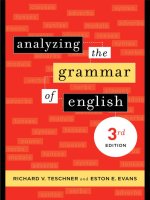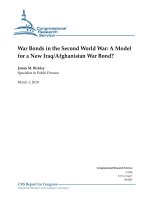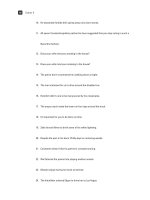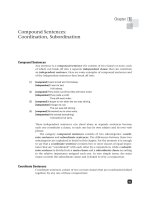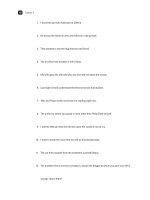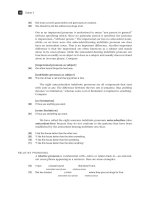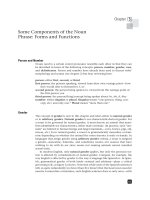Analyzing the markets opportunity for a new product the case of thread deformed bar steel of vina kyoel steel company
Bạn đang xem bản rút gọn của tài liệu. Xem và tải ngay bản đầy đủ của tài liệu tại đây (465.7 KB, 83 trang )
ANALYZING THE MARKET’S OPPORTUNITY FOR A NEW
PRODUCT – THE CASE OF “THREAD DEFORMED BAR STEEL” OF
VINA KYOEI STEEL COMPANY
In Partial Fulfillment of the Requirements of the Degree of
MASTER OF BUSINESS ADMINISTRATION
In Marketing
By
Mr: Vu Duy Long
ID: MBA03019
International University - Vietnam National University HCMC
February 2013
ANALYZING THE MARKET’S OPPORTUNITY FOR A NEW
PRODUCT – THE CASE OF “THREAD DEFORMED BAR STEEL” OF
VINA KYOEI STEEL COMPANY
In Partial Fulfillment of the Requirements of the Degree of
MASTER OF BUSINESS ADMINISTRATION
In Marketing
By
Mr: Vu Duy Long
ID: MBA03019
International University - Vietnam National University HCMC
February 2013
Under the guidance and approval of the committee, and approved by all its members,
this thesis has been accepted in partial fulfillment of the requirements for the degree.
Approved:
---------------------------------------------Chairperson
---------------------------------------Committee member
---------------------------------------------Committee member
---------------------------------------Committee member
---------------------------------------------Committee member
---------------------------------------Committee member
Acknowledge
To complete this thesis, I have been benefited from the following people: Dr.
Ho Nhut Quang (Thesis Advisor) who has committed to instruct me to accomplish
this thesis, and Mr. Tran Ngoc Tuan (General Manager of Vina Kyoei Steel
Company) who helped me to test and support more opinions for my questionnaire
adjusted.
-i-
Plagiarism Statements
I would like to declare that, apart from the acknowledged references, this
thesis either does not use language, ideas, or other original material from anyone; or
has not been previously submitted to any other educational and research programs or
institutions. I fully understand that any writings in this thesis contradicted to the above
statement will automatically lead to the rejection from the MBA program at the
International University – Vietnam National University Hochiminh City.
- ii -
Copyright Statement
This copy of the thesis has been supplied on condition that anyone who
consults it is understood to recognize that its copyright rests with its author and that
no quotation from the thesis and no information derived from it may be published
without the author’s prior consent.
© Vu Duy Long / MBA03019 / 2013
- iii -
Table of Contents
Chapter 1 - Introduction ......................................................................................... 1
1. Research problem ..................................................................................................1
2. Significance of thesis ............................................................................................. 4
3. Scope and limitation of thesis ................................................................................ 5
4. Objectives of thesis................................................................................................ 5
5. Research methodology........................................................................................... 5
6. Thesis structure......................................................................................................6
Chapter 2 - Literature review ................................................................................. 8
1. The market’s opportunity....................................................................................... 8
2. Need ...................................................................................................................... 8
3. Want...................................................................................................................... 9
4. Industry ................................................................................................................. 9
5. Ability ................................................................................................................. 10
6. Brand................................................................................................................... 11
7. Intention .............................................................................................................. 11
8. Environment ........................................................................................................ 12
8.1. Political ............................................................................................................ 12
8.2. Economic.......................................................................................................... 13
8.3. Social................................................................................................................ 13
8.4. Technological ................................................................................................... 13
8.5. Environmental .................................................................................................. 13
8.6. Legal ................................................................................................................ 14
8.7. Hedging against the macro environment ........................................................... 14
9. Related research about the market’s opportunity .................................................. 15
- iv -
10. Research model and hypotheses ......................................................................... 17
Chapter 3 - Research methodology....................................................................... 19
1. Research process ................................................................................................. 19
2. Research methodology......................................................................................... 19
3. Quantitative approach .......................................................................................... 20
3.1. Sampling .......................................................................................................... 20
3.2. Interview with General Manager of Vina Kyoei Steel Company ....................... 21
3.3. Pilot study......................................................................................................... 22
3.4. Data collection.................................................................................................. 22
3.5. Data analysis..................................................................................................... 23
3.5.1. Descriptive statistics ...................................................................................... 23
3.5.2. Reliability statistics ........................................................................................ 24
3.5.3. Exploratory factor analysis............................................................................. 24
3.5.4. Correlation testing.......................................................................................... 25
3.5.5. Regression analysis ........................................................................................ 26
3.5.6. Crosstabs analysis .......................................................................................... 26
3.6. The measurement scale ..................................................................................... 27
Chapter 4 - Data analysis & Research result........................................................ 30
1. General outlook of economic environment in Vietnam......................................... 30
1.1 Macroeconomic environment............................................................................. 30
1.2 Industry ............................................................................................................. 32
2. Sample description .............................................................................................. 34
3. Descriptive statistics ............................................................................................ 34
3.1. Need dimension ............................................................................................... 34
3.2. Want dimension................................................................................................ 36
-v-
3.3. Industry dimension ........................................................................................... 37
3.4. Ability dimension ............................................................................................. 39
3.5. Intention dimension .......................................................................................... 40
3.6. Opportunity dimension ..................................................................................... 41
3.7. Brand dimension............................................................................................... 42
4. Reliability test...................................................................................................... 44
5. Exploratory factor statistics.................................................................................. 48
6. Correlation testing ............................................................................................... 53
7. Regression analysis.............................................................................................. 55
8. Crosstabs analysis................................................................................................ 57
9. Hypotheses testing result ..................................................................................... 60
Chapter 5 - Conclusions and Recommendations.................................................. 62
1. Conclusion........................................................................................................... 62
2. Practical implication ............................................................................................ 64
3. Limitations and recommendations for future researchers...................................... 67
List of references ..................................................................................................... 69
- vi -
List of Tables
Table 1: The related research about the market’s opportunity................................... 15
Table 2: List of Hypotheses ..................................................................................... 18
Table 3: The measurement scale .............................................................................. 27
Table 4: The producing and selling situation of producers in December 2012 .......... 33
Table 5: Descriptive Statistics of Need dimension ................................................... 35
Table 6: Descriptive Statistics of Want dimension ................................................... 36
Table 7: Descriptive Statistics of Industry dimension............................................... 37
Table 8: Statistics of Ability .................................................................................... 39
Table 9: Statistics of Intention ................................................................................. 40
Table 10: Descriptive Statistics of Opportunity dimension....................................... 41
Table 11: Statistics of Brand .................................................................................... 42
Table 12: Need dimension reliability test ................................................................. 44
Table 13: Want dimension reliability test................................................................. 45
Table 14: Industry dimension reliability test ............................................................ 45
Table 15: Industry dimension reliability re-test ........................................................ 46
Table 16: Opportunity dimension reliability test ...................................................... 47
Table 17: Opportunity dimension reliability re-test .................................................. 47
Table 18: KMO and Bartlett's Test........................................................................... 48
Table 19: Total Variance Explained......................................................................... 49
Table 20: Component Matrixa .................................................................................. 50
Table 21: Rotated Component Matrixa ..................................................................... 50
Table 22: Correlations ............................................................................................. 53
Table 23: Correlations re-test................................................................................... 54
Table 24: Model summary ....................................................................................... 55
- vii -
Table 25: ANOVAb ................................................................................................. 55
Table 26: Coefficientsa ............................................................................................ 56
Table 27: Chi-Square Tests (Opportunity – Brand) .................................................. 57
Table 28: Correlations (Opportunity – Brand).......................................................... 58
Table 29: Chi-Square Tests (Opportunity – Intention).............................................. 59
Table 30: Correlations (Opportunity – Intention) ..................................................... 60
Table 31: Hypotheses testing result.......................................................................... 60
Table 32: The final consequences ............................................................................ 63
- viii -
List of Figures
Figure 1: The sales revenue of Vina Kyoei Steel Company from 2010 – 2012 ............2
Figure 2: Path of Conceptual Frame Work................................................................ 4
Figure 3: Research Methodology Framework............................................................ 6
Figure 4: The proposed research model................................................................... 17
Figure 5: Research process ..................................................................................... 19
Figure 6: Customer’s ability.................................................................................... 39
Figure 7: Customer’s intention ................................................................................ 40
Figure 8: Brand awareness...................................................................................... 43
- ix -
Abstract
In the current context of the integrated economy, the competition in the steel
industry became increasingly fierce. This is both an opportunity and challenge for the
company as Vina Kyoei to show the ability to adapt to the market’s reality, improve
the technology and the management system in order to create the competitiveness to
other competitors. Therefore, Vina Kyoei Steel Company has been studying the
market to offer a new steel product with more advantages over traditional steel
products on the market; this is the pioneer company in Vietnam to produce this new
steel product as well. In this study, I will conduct the market research to understand
and clarify opportunities and challenges for this new product. In addition, the results
of the study will help the company has a better insight about the market and
customers, and it is the basis for future studies as well.
Keywords: thread deformed bar steel, new steel, opportunity, ability, brand.
-x-
- xi -
Chapter 1 - Introduction
The first chapter will provide a general introduction for the current study
through 6 sections. This chapter presents the problem of this research, the significance
of the thesis, the scope and limitation of the thesis, objectives of the thesis, research
methodology, and thesis structure.
1. Research problem
Cost, revenue and profit are three most important factors in determining the
success of your business. A business can have high revenue, but if the costs are
higher, it will show no profit and is destined to go out of business when the available
capital runs out. Managing costs and revenue to maximize profit is the key for any
entrepreneur.
Many businesses are judged on the basis of revenues, not profit. For example,
an Internet start-up may show high revenues even in the early stages of the business
but will typically spend far more money than total revenue on business expansion and
marketing. This is only possible when investors are available to provide additional
capital (the term for investment money provided to the business that allows it to spend
more money than it brings in). In the long run, a business that requires constant
investment will fail; only a profitable business will be able to pay back its investors.
Sometimes, however, an entrepreneur may be able to personally succeed if he can sell
his business while it is unprofitable, if investors believe the chance of future
profitability is high. In most cases, however, only profitable businesses can be sold at
reasonable prices to new owners.
-1-
In general usage, revenue is income received by an organization in the form
of cash or cash equivalents. Sales revenue or revenues are the income received from
selling goods or services over a period of time.
From the first half 2012, sales revenue of Vina Kyoei Steel Company started
to decrease.
Sales revernue from 2010 - 2012
4000
3550
Billion VND
3500
2990
3000
2600
2500
2000
1500
1200
1000
500
0
Second half
2010
First half 2011
Second half
2011
First half 2012
Figure 1: The sales revenue of Vina Kyoei Steel Company from 2010 – 2012
Nowadays, there are so many steel companies in Vietnam such as: VN Steel,
Pomina Steel, Hoa Phat Steel, and so on. Therefore, the competition has been being
very fierce, and especially in Ho Chi Minh City’s market. The market’s shares are
narrowing down for many steel makers. The question made for each company now is
how to protect and increase the sales.
Vina Kyoei Steel Company is one of the leading companies in this industry.
However, in order to keep its current market’s share not only stable but also bigger is
always the priority.
-2-
One of strategies that Vina Kyoei Steel Company used is the marketing
strategy (introduce the new product). On over the world and Vietnam in particular, the
steel which they use for construction normally is Deformed Bar Steel; because mostly
steel producers have been producing this kind of steel commonly. But, following the
traditional way to connect or link two steel bars together; constructors normally use
methods such as: welding, overlapping and tightening, or threading which can be
costly, time consuming, labor consuming, or even not stable.
Catching up that problem, Vina Kyoei Steel Company plans to launch out the
new product “Thread Deformed Bar Steel” which can hopefully handle those
problems above. With this new product, Vina Kyoei Steel Company promisingly can
be successful and gain more market’s share.
However, the success of the new product introduction still remains a question
to the company because it has no market information about the customers’ behaviors
toward this new steel. There should be a market research to understand more about
the customer’s behavior, and that is the reason why I decide to choose the topic:
ANALYZING THE MARKET’S OPPORTUNITY FOR A NEW
PRODUCT – THE CASE OF “THREAD DEFORMED BAR STEEL” OF VINA
KYOEI STEEL COMPANY
The topic aims to answer the following question: “What is the market’s
opportunity for the new product (Thread Deformed Bar Steel)?”
The thesis is based on the following conceptual framework to solve the
research problem:
-3-
Problem:
Sales face the
fierce competition
How to
protect and
increase sales
Marketing
strategy
Adjust the
existing product
Product
Price
New market for
the existing
product
Introduce the
new product
Place
Promotion
Success
Increase sales
Figure 2: Path of Conceptual Frame Work
2. Significance of thesis
Successfully launching a new product campaign is obviously the tentative
purpose of the thesis. Besides, the topic is expected to:
Help to increase the sales for Vina Kyoei Steel Company.
Introduce the new product which is better than the existing one.
-4-
Furthermore, this topic is the initially significant step for Vina Kyoei Steel
Company to marketing the new product to the Vietnam’s market and Ho Chi Minh
City’s market especially.
It will help the company having the good insight of the market, customer’s
behavior, customer’s need, the properly and suitable marketing programs for the new
product.
3. Scope and limitation of thesis
Ho Chi Minh City was chosen to survey because the demand for steel products
here is large and very potential. And we will focus mainly on recent customers
(construction contractors) of Vina Kyoei Steel Company.
The secondary data will be collected from year 2010 – 2012.
The study will be conducted from June to December – year 2012.
4. Objectives of thesis
To solve the research question mentioned above, the objectives of the thesis
are to:
Review theory about customer’s demand and customer buying process.
Explore market’s opportunities for the new product “Thread Deformed Bar
Steel” of Vina Kyoei Steel Company.
Suggestion and recommendation for Vina Kyoei Steel Company.
5. Research methodology
This thesis was undertaken by using both qualitative and quantitative method,
collect secondary data and primary data by in-depth interview and survey making.
-5-
Problem statement
Objectives
1. Review theories
Descriptive statistic and collecting
secondary data
2. Explore market’s opportunities for
the new product
Survey on customer, Quantitative
method, Using SPSS software
Result of research
Recommendation
Figure 3: Research Methodology Framework
6. Thesis structure
The structure of this thesis includes five chapters:
Chapter 1 - Introduction: This chapter contains the general background of
Vina Kyoei Steel Company and the new product as well.
Chapter 2 - Literature review: This chapter introduces the related concepts
and theories regarding to this thesis, and examines research studies which are
made by other researchers.
Chapter 3 - Research methodology: This chapter presents an over view of
the approaches used to conduct this research.
Chapter 4 - Data analysis and Research result: This chapter focuses on
analyzing and discussing the results obtained from the collected data.
-6-
Chapter 5 - Conclusions and Recommendations: This chapter focuses on
discussing the final results of study and suggestions for the new product in the
future.
-7-
Chapter 2 - Literature review
This chapter focuses on introducing the related concepts and theories that are
used in my thesis. It means this chapter will introduce the literature review of the
market’s opportunity in order to give a clear idea about the research area and discuss
previous studies on the market’s opportunity.
1. The market’s opportunity
Nothing is more important for any enterprise than to find and exploit new
market opportunities. Even when business is robust, there is always the need to hunt
for new turf, to guard against the time when a strong product or service category will
become static or declining. The skill in finding new market opportunities is the
lifeblood of business worldwide.
According to Redfern & Snedker (2002), market opportunity means newly
identified needs, wants, and demand that a firm can exploit because it is not being
addressed by the competitors. Therefore, in order to know what the market
opportunities of any company are, we have to figure out three basic things of the
market (needs, wants, and demand).
2. Need
Philip Kotler (1997) stated that the most basic concept underlying marketing is
that of human needs. A human need is a state of felt deprivation. Humans have many
complex needs. These include basic physical needs for food, clothing, warmth and
safety; social needs for belonging and affection; and individual needs for knowledge
and self-expression. These needs are not invented by marketers; they are a basic part
-8-
of the human make-up. When a need is not satisfied, a person will do one of two
things:
Look for an object that will satisfy it; or
Try to reduce the need.
3. Want
Kotler (1997) also defined Human wants are the form taken by human needs
as they are shaped by culture and individual personality. A hungry person in Bahrain
may want a vegetable curry, mango chutney and lassi. A hungry person in Eindhoven
may want a ham and cheese roll, salad and a beer. A hungry person in Hong Kong
may want a bowl of noodles, char siu pork and jasmine tea. Wants are described in
terms of objects that will satisfy needs. As a society evolves, the wants of its members
expand. As people are exposed to more objects that arouse their interest and desire,
producers try to provide more want-satisfying products and services.
4. Industry
In economics, the competition is the rivalry among sellers trying to achieve
such goals as increasing profits, market share, and sales volume by varying the
elements of the marketing mix: price, product, distribution, and promotion. MerriamWebster defined competition in business as "the effort of two or more parties acting
independently to secure the business of a third party by offering the most favorable
terms". It was described by Adam Smith in The Wealth of Nations (1776) and later
economists as allocating productive resources to their most highly-valued uses, and
encouraging efficiency. Smith and other classical economists before Cournot were
referring to price and non-price rivalry among producers to sell their goods on best
-9-
terms by bidding of buyers, not necessarily to a large number of sellers nor to a
market in final equilibrium.
Later microeconomic theory distinguished between perfect competition and
imperfect competition, concluding that no system of resource allocation is more
Pareto efficient than perfect competition. Competition, according to the theory, causes
commercial firms to develop new products, services and technologies, which would
give consumers greater selection and better products. The greater selection typically
causes lower prices for the products, compared to what the price would be if there was
no competition (monopoly) or little competition (oligopoly).
5. Ability
Consumer buying power is the behavior of a consumer in regards to how he
spends money on goods or services. For example, an individual might have $1,000
per month to spend on goods after he pays taxes. This sum of money is known as his
consumer buying power because it is the amount he is able to contribute to the
economy through purchases. This amount is then divided among actual purchases to
find out how consumer buying power is allocated among different industries such as
entertainment, food, housing and clothing.
Philip Kotler (1997) examined stages that buyers pass through to reach a
buying decision. The consumer passes through five stages: need recognition,
information search, and evaluation of alternatives, purchase decision and postpurchase behavior.
- 10 -
6. Brand
A brand is a name, term, sign, symbol, or design which is intended to identify
the goods or services of one seller or group of sellers and to differentiate them from
those of competitors. Besides, brand also is what is experienced and valued by
customers in everyday social life, the culture of the product – shared taken – for
granted brand stories; images; and associations, and the mental and emotional file we
have for a product or service or entity.
Rossiter and Percy (1987) described brand awareness as being essential for the
communications process to occur as it precedes all other steps in the process. Without
brand awareness occurring, no other communication effects can occur. For a
consumer to buy a brand they must first be made aware of it. Brand attitude cannot be
formed, and intention to buy cannot occur unless brand awareness has occurred
(Rossiter & Percy 1987; Rossiter et al. 1991).
In memory theory, brand awareness is positioned as a vital first step in
building the “bundle” of associations which are attached to the brand in memory
(Stokes, 1985). The brand is conceptualized as a node in memory which allows other
information about the brand to be “anchored” to it (Aaker, 1991). The
conceptualization of a network of brand associations in memory with the brand as a
central core has been put forward by many others (eg. Keller 1993; Holden 1993;
Holden & Lutz 1992).
7. Intention
An intention has been defined as a person’s commitment, plan, or decision to
carry out an action or achieve a goal (Eagly & Chaiken, 1993), and in fact has been
used synonymously at times with choice, decision, and plan. All these usages more
- 11 -
generally fall under the label volition. Psychologist Ajzen (1991, p.181) conceives of
intentions rather broadly as “indicators of how hard people are willing to try, of how
much of an effort they are planning to exert”.
This definition seems too broad in that it encompasses (i) motivation, which is
better construed as an antecedent of intention and (ii) planning, which constitutes a
mental activity or process that often occurs after one form an intention to pursue a
goal or perform an action.
The need for a narrower definition of intention can be seen in Lewin’s (1951,
pp.95–96) specification of the role of volition in action: “A complete intentional
action is conceived as follows: Its first phase is a motivational process, whether a brief
or a protected vigorous struggle of motives; the second phase is an mental act of
choice, decision, or intention, terminating this struggle; the third phase is the
consummatory intentional action itself”. This clearly differentiates intention from
motivation and action and situates it between these concepts: motivation → intention
→ action.
8. Environment
Macro environment factors are uncontrollable external forces that affect how a
business operates. They are largely out of the control of the business, and often
require changes in operating, management, production, and marketing. Analysts often
categorize them using the acronyms PEST or PESTEL. Broken down, PEST stands
for political, economic, social, and technological concerns. PESTEL also includes
environmental and legal factors.
8.1. Political: Political macro environment factors include things like tax
policies, government-issued safety regulations, the availability of government
- 12 -

